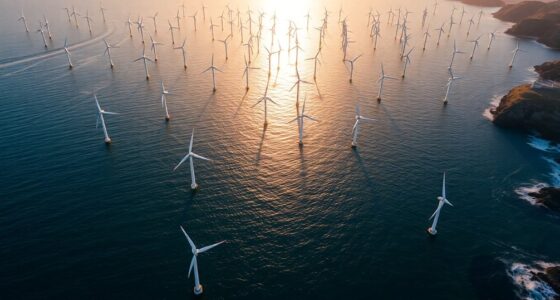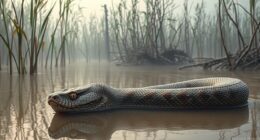Aquatic animals are key players in addressing ocean dilemmas. Equipped with biologging sensors, they gather crucial data on pollution, climate change, and habitat use. This information reveals how human activities affect marine life and ecosystems. By assessing the health of these animals, you can better understand the challenges facing our oceans. Their movements and behaviors inform conservation efforts and help protect vulnerable areas. Keep exploring to uncover more about how aquatic life aids in ocean preservation.
Key Takeaways
- Aquatic animals equipped with biologging sensors provide crucial data on environmental changes, enhancing our understanding of ocean health.
- Tracking movements of marine species reveals the impacts of human activities like pollution and overfishing, guiding conservation efforts.
- Biologging helps identify critical areas affected by plastic pollution, aiding in targeted protection and habitat conservation measures.
- Data collected on habitat use and migration patterns improves knowledge of ecosystems, vital for addressing climate change and ocean acidification threats.
- Community involvement in ocean conservation, inspired by understanding aquatic animals' roles, fosters collective action for sustainable practices and cleaner oceans.

As our oceans face increasing threats from human activities, understanding the vital role aquatic animals play in monitoring these changes becomes crucial. You mightn't realize it, but marine animals equipped with biologging sensors are becoming key players in ocean health assessment. By attaching small devices that weigh less than 3% of an animal's body weight, researchers can gather valuable data on ocean conditions like temperature and salinity. This method helps fill gaps that satellites and research vessels often miss.
Marine animals with biologging sensors are crucial in assessing ocean health and monitoring environmental changes.
When these animals move about their natural habitats, they provide insights into environmental changes that can directly affect their ecosystems. For instance, tracking their movements can reveal how pollution, overfishing, and noise pollution impact marine life. You may find it surprising that the illegal fishing activities affecting endangered species have been exposed through biologging technology. This kind of data helps create a clearer picture of the threats faced by marine life today. Notably, marine debris from mismanaged landfills is a significant contributor to the plastic pollution problem.
Moreover, plastic pollution poses a significant challenge. It can lead to entanglement and ingestion by marine creatures, resulting in injuries or deaths. When small species consume microplastics, these harmful particles can move up the food chain, potentially affecting human health. Biologging devices help track these dangers, enabling conservationists to identify critical areas needing protection and action.
The role of aquatic animals in data collection extends beyond monitoring pollution. These sensors allow animals to gather information in otherwise inaccessible areas, providing insights into habitat use and migration patterns. Such data is vital for understanding how climate change and ocean acidification threaten marine ecosystems, including coral reefs and the diverse life they support.
You can contribute to ocean conservation by supporting sustainable practices, reducing plastic use, and participating in community cleanups. By understanding the role of aquatic animals in solving ocean dilemmas, you become part of the solution, helping to protect these vital ecosystems for future generations.
Frequently Asked Questions
How Do Aquatic Animals Affect the Ocean's Ecosystem Balance?
Aquatic animals play a crucial role in maintaining the ocean's ecosystem balance.
You'll notice that they control prey populations, preventing overgrazing and harmful algal blooms. By doing this, they help stabilize habitats and support diverse marine life.
Their presence also aids in nutrient cycling, ensuring a healthy food web.
Ultimately, when you observe a thriving marine environment, you can thank these creatures for their vital contributions to ecological stability and resilience.
What Are Some Endangered Aquatic Species Contributing to Ocean Health?
When it comes to ocean health, you can't judge a book by its cover.
Endangered species like the blue whale and the vaquita play vital roles in maintaining ecosystem balance. The blue whale helps nutrient cycling while the vaquita's presence indicates a healthy marine environment.
How Do Human Activities Impact Aquatic Animals' Roles in the Ocean?
Human activities significantly impact aquatic animals' roles in the ocean. When you overfish, you disrupt food chains, leaving predators and prey vulnerable.
Pollution from plastics and chemicals harms marine life, affecting their survival and behavior. Climate change alters habitats, forcing species to adapt or migrate.
Unsustainable practices further stress populations, reducing their ability to maintain ecosystem balance. If you don't take action, these factors can lead to irreversible damage in marine environments.
Can Technology Help Enhance the Contributions of Aquatic Animals?
Imagine a vibrant underwater world, where technology dances alongside aquatic life. You can enhance aquatic animals' contributions by employing drones and sensors that monitor their health and habitats.
This tech helps detect diseases and track movements, ensuring a thriving ecosystem. With AI analyzing data from whale calls and habitat models, you reduce ship strikes.
Integrating these innovations not only protects marine life but also fosters a sustainable ocean, where nature and technology coexist harmoniously.
What Are Effective Conservation Strategies for Protecting Aquatic Species?
To effectively protect aquatic species, you should focus on several key strategies.
Start by restoring critical habitats and managing water quality to support native populations. Collaborate with local and federal agencies for broader impact.
Implement adaptive management practices to adjust based on ongoing data. Encourage community engagement through awareness campaigns and sustainable practices, like reducing plastic waste.
Lastly, consider species-specific approaches, such as hatcheries, to help reintroduce endangered species into their natural environments.
Conclusion
In the grand tapestry of our oceans, aquatic animals aren't just inhabitants; they're vital contributors to solutions. They purify our waters, balance ecosystems, and inspire innovations. By protecting their habitats, we're not only ensuring their survival but also embracing a future where marine life helps tackle climate change, restores coral reefs, and supports sustainable fishing. So, let's champion these creatures, celebrate their roles, and commit to preserving the ocean's health—because together, we can forge a brighter, bluer tomorrow.








